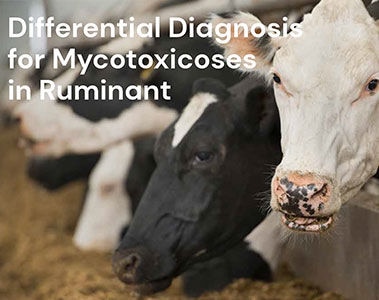
-
Global/EN
- Global
- North America
- Latin America
In Brief
The intake of feed by an animal is closely tied to its ability to either increase body weight or yield milk. Greater food consumption generally leads to higher production. Maintaining an optimal Daily Dry Matter Intake (DMI) is crucial during transition periods like after calving in dairy cows to reduce metabolic issues and enhance reproductive performance or when switching beef animals into a feedlot regime. The trichothecenes family is notorious for its detrimental effects on mammalian appetite due to its ability to trigger the release of the satiety hormone known as CCK, which induces a sense of fullness and reduces feed intake.
During a study conducted by Duringer (2021) at Oregon State University, the impact on feed intake was evident when comparing the diets of two different groups of beef steers, as seen in Figure 1. The intake of fattening steers started better for the control animals than those with contaminated diets. Still, quickly after the treatment, the mycotoxins suppressed the intake of the treated animals. The DMI reduction resulted immediately into a decreased weight gain compared to the control.
Mycotoxins disrupt the typical functioning of the microbiota inhabiting the rumen, which is essential for achieving optimal fermentation and feed digestion. As their name implies, mycotoxins are toxic substances that apply an antimicrobial effect, inhibiting the normal activity of the rumen. In Figure 2, we can observe the influence of contamination by multiple mycotoxins on the presence of various microbial groups within the control group, which significantly dampens their activity. However, the supplementation of Mycofix® at two different dosages proved effective in protecting the microbes from the adverse effects of mycotoxins and, as a result, there was a restored microbial growth and activity when compared to the diet contaminated with mycotoxins.
Having a higher microbial population in the rumen means they are degrading the feed better and reproducing more. These are positive outcomes in every way for the cow and ultimately for the farm profit. Before using any rumen-boosting additive, properly deactivating mycotoxins in the feed is essential for ensuring maximum nutrient utilization.
During a trial conducted by Gallo et al. (2021) with relatively low contamination of deoxynivalenol and fumonisins on high-yielding dairy cows, the digestibility of dry matter (DM) and neutral detergent fiber (NDF) was greatly reduced. Thanks to the protective effect of Mycofix® the digestibility was recovered to a level even higher than control (p<0.05), which means that there is an advantage of deactivating mycotoxins even if contamination is very low (control levels).
While studying the adverse effects of mycotoxins on ruminal conditions and digestibility, we were able to demonstrate the protective efficacy of Mycofix®. Although numerous products in the market assert their ability to bind mycotoxins, the mycotoxins investigated in the recent scientific trials vary significantly and cannot be effectively addressed using a one-size-fits-all approach.
Mycotoxins have the potential to limit both beef and dairy productivity through various mechanisms: (1) diminished feed intake, suppressed microbial activity, and (2) reduced digestibility of DM (Dry Matter) and (3) NDF (Neutral Detergent Fiber). For ruminant experts seeking improved productivity, a key piece of advice is to first ascertain whether mycotoxins are constraining the achievement of your goals. Once mycotoxins have been addressed, consider implementing the right management, nutritional, and technological strategies to enhance performance.
17 October 2023
Ignacio holds a bachelor's in Agriculture Sciences and a master's in Sustainable Animal Nutrition and Feeding. He is the Global Marketing Manager for Ruminants at dsm-firmenich, and has supported farmers, nutritionists, and health experts on promoting productive performance through health protection and efficient use of resources.
Not all products are available in all markets nor associated claims allowed in all regions (including but not limited to USA and Canada).
We detected that you are visitng this page from United States. Therefore we are redirecting you to the localized version.